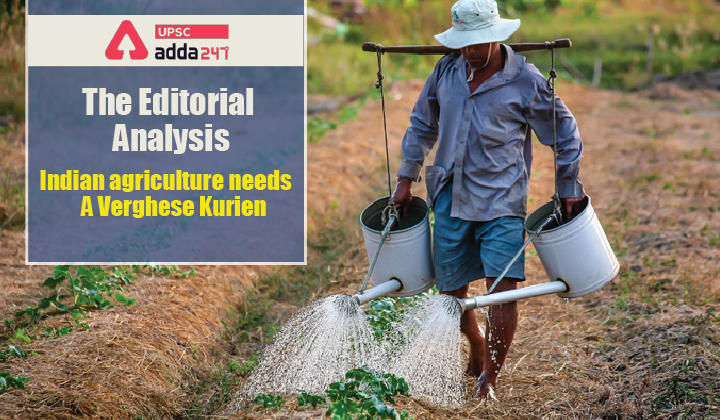Table of Contents
Relevance
- GS 3: Storage, transport and marketing of agricultural produce and issues and related constraints
Context
- Nov 26, 2021 marked the 100th birth anniversary of the Milk man of India, Verghese Kurien.
Who was Verghese Kurien?
- Kurien was from Kerala and got education in a western university in a subject like metallurgy which is far removed from agriculture.
- He designed the idea of Amul as a co-operative, made it a global brand and later launched the White Revolution that made India the largest milk producing nation in the world.
- Gandhian ideology: Kurien’s fascination for the co-operative model was influenced by Gandhian thinking on poverty alleviation and social transformation.
- He viewed co-operatives as the closest embodiment of Mahatma Gandhi’s powerful insight that “what the world needs is not mass production, but production by the masses”.
The Kurien’s way
- Co-operative model of business development was the centre of Kurien’s vision.
- He put farmers in the centre of India’s journey of development and won the farmers over with his professional integrity.
- He believed that India’s place in the sun will come from the partnership between the wisdom of its rural people and the skill of its professionals.
- He did not shy away from incorporating ideas and the practices of the corporate world because it nis known that areas such as innovations in marketing and management, branding and technology, the private sector excels and sets benchmarks for businesses across the world to follow and adopt.
Growth of Amul
- Amul has grown steadily, diversifying its product range and adding new ones.
- Amul continues to remain one of India’s best-known food brands and is an inspiration to other dairy cooperatives such as Nandini in Karnataka, Aavin in Tamil Nadu and Verka in Punjab.
Focus on digital revolution
- India’s digital revolution has bypassed the agriculture sector.
- We have smart cities, not smart villages, nor even liveable villages.
- Cooperative movement in India has suffered due to lack of professional management, adequate finance and poor adoption of technology.
- The pandemic has further deepened the urban-rural divide.
- While the corporate sector is booming due to the booming stock market, incomes are drying in rural India.



 TSPSC Group 1 Question Paper 2024, Downl...
TSPSC Group 1 Question Paper 2024, Downl...
 TSPSC Group 1 Answer key 2024 Out, Downl...
TSPSC Group 1 Answer key 2024 Out, Downl...
 UPSC Prelims 2024 Question Paper, Downlo...
UPSC Prelims 2024 Question Paper, Downlo...




